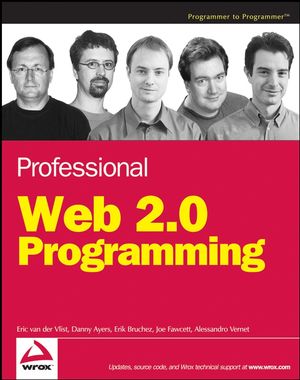Professional Web 2.0 ProgrammingISBN: 978-0-470-08788-6
Paperback
552 pages
November 2006
 This title is out-of-print and not currently available for purchase from this site.
|
Acknowledgments.
Introduction.
Chapter 1: Hello Web 2.0 World.
Introducing BuzzWatch.
Charting the Landscape.
Exploring Behind the Scene.
Making BuzzWatch a Better Web Citizen.
Making BuzzWatch More Maintainable.
Applying the Final Touch.
Conclusion.
Chapter 2: Page Presentation.
Creating Clean and Simple Pages.
From HTML to XHTML.
The Document Object Model.
Cascading Style Sheets.
Tools.
Summary.
Chapter 3: JavaScript and Ajax.
JavaScript: Understanding Lesser-Known but Crucial Features.
JavaScript Optimizations.
Ajax.
Summary.
Chapter 4: Design Principles.
Common Design Issues.
Summary 109
Chapter 5: What’s Next for Web 2.0?
XSLT and XPath.
SVG.
XForms.
What’s Next for HTML.
Summary.
Chapter 6: Rich Client Alternatives.
From Browsers to Rich Clients.
Comparing Rich Client Frameworks.
Summary.
Chapter 7: HTTP and URIs.
How the Web Was Won.
Web 1.0: HTML, URLs, and HTTP.
The Web Model and REST.
Considerations for Building an HTTP Service.
What’s on the Wire?
More Representations.
Summary.
Chapter 8: XML and Its Alternatives.
XML.
Alternatives to XML.
Summary.
Chapter 9: Syndication.
Some Syndication Basics.
The Syndication Process.
Syndication Formats.
Summary.
Chapter 10: Microformats.
The Basics of Microformats.
Creating Microformat Documents.
Summary.
Chapter 11: Combining Protocols to Build Web Services.
Clarifying Web Services.
REST Services.
WS-* Services.
REST versus WS-*.
Summary.
Chapter 12: Serving XML over HTTP.
How Is Serving HTML Different?
Serving Static Content.
Serving Dynamic Content.
XQuery and XML Databases.
Serving JSON.
Summary.
Chapter 13: Databases and Non-XML Sources.
Dealing with Non-XML Sources.
Converting Relational Data to XML.
Converting Binary Data to XML.
Summary.
Chapter 14: Creating Syndication Channels.
A Simple Atom Service.
Running the Application.
Adding E-mail Support.
Summary.
Chapter 15: Mashups, HTML Scraping, and Web Services.
Popular Examples: Mapping Mashups.
Why Use Mashups?
The Business Model of Mashups.
Screen Scraping.
Creating Feeds.
Mapping and Badges.
Summary.
Chapter 16: Implementing and Maintaining Your URI Space.
Future-Proofing Your URIs.
Managing Change in Your URI Space.
Your URI Mapping Toolbox.
Summary.
Chapter 17: Podcasting and Serving Multimedia.
The Formats Labyrinth.
Protocols.
Summary.
Chapter 18: Security.
What Is Security?
Lessons Learned from History.
The Layered Approach.
Authentication and Authorization.
Message Encryption.
Message Digests.
Digital Certificates.
Secure Sockets Layer.
Code Security.
Web Services Security.
Summary.
Index.



